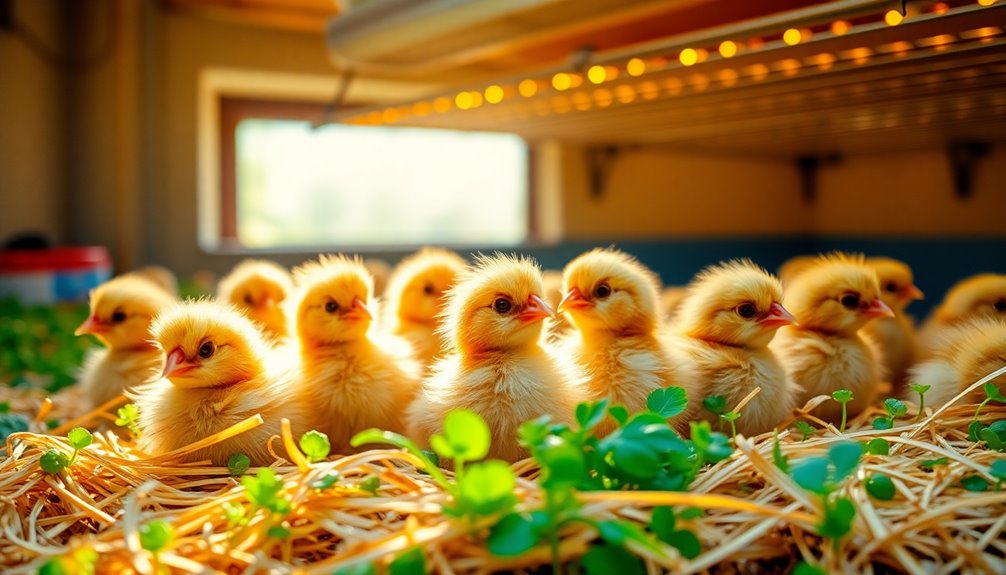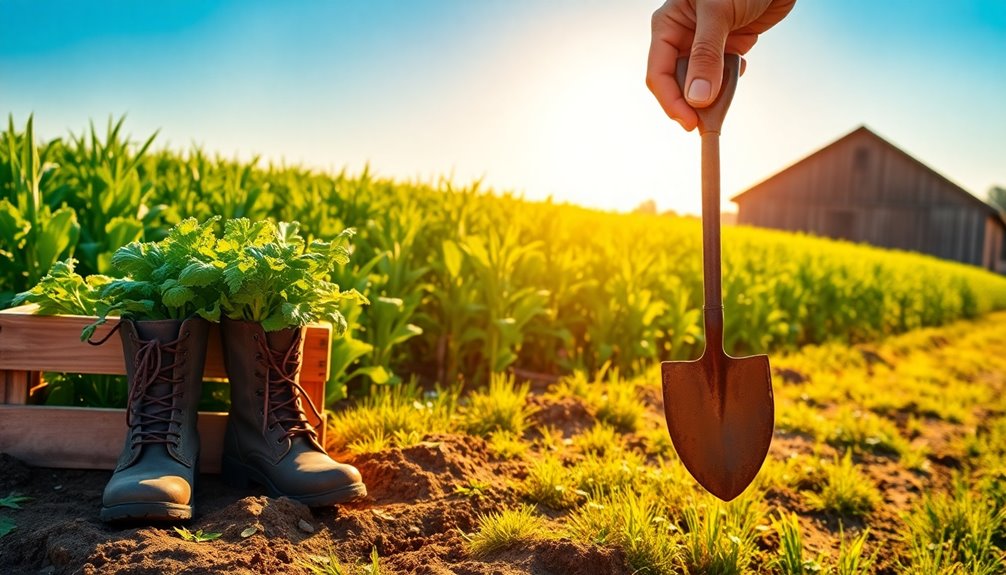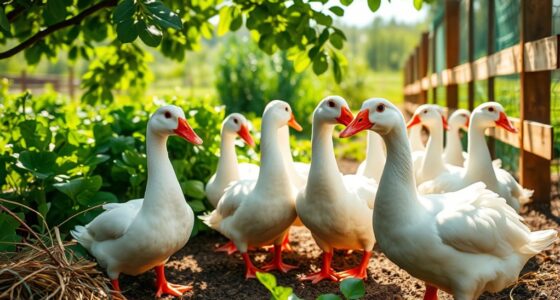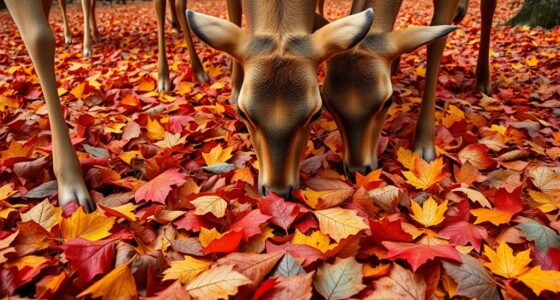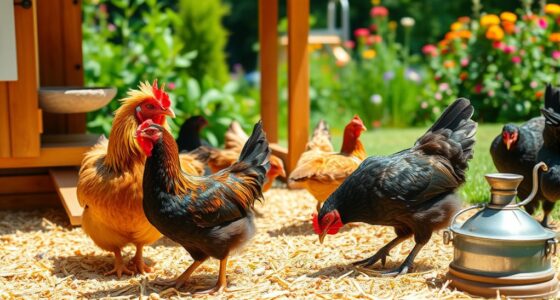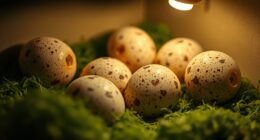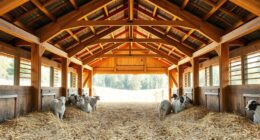To raise healthy and happy young quail from day one, start with a proper brooding setup. Maintain a temperature of 95°F, decreasing by 5°F each week. Provide 0.5 square feet per chick to reduce stress and aggression. Feed them a high-protein crumble with 25-30% protein, and guarantee fresh water is always available. Keep an eye on their health; watch for lethargy and aggression. Offer enriched environments with things to forage for and safe hiding spots. With the right care, you'll have thriving quail. Keep going, and you'll discover more tips for securing their well-being.
Key Takeaways
- Start with a brooder temperature of 95°F and decrease by 5°F weekly to ensure optimal growth conditions.
- Provide 0.5 square feet of space per chick to minimize stress and aggression.
- Feed a high-protein crumbled diet (25-30% protein) for rapid growth and ensure fresh water is always accessible.
- Monitor health for signs of issues like lethargy and splay legs, while maintaining cleanliness in water sources.
- Incorporate enrichment activities like foraging and dust baths to promote mental stimulation and well-being.
Understanding Young Quail
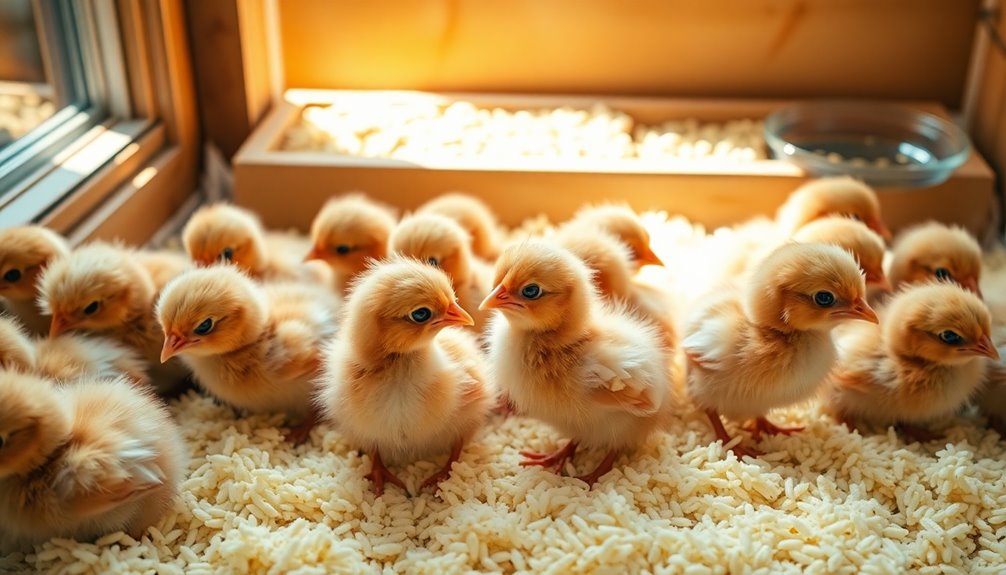
Understanding young quail starts with guaranteeing they've the right environment. For ideal growth, quail chicks need a brooder maintained at about 95°F (35°C) during their first week, gradually decreasing by 5°F weekly until they're fully feathered.
Each bird should have around 0.5 square feet of space to reduce stress and promote healthy development. A high-protein diet is essential, so provide crumbled feed containing 25-30% protein for easier digestion.
Always verify fresh water is accessible, using shallow dishes to prevent drowning. Regularly monitor for health issues like temperature regulation and signs of splay legs or aggression, as these can affect your young quail's well-being and growth.
Keeping these factors in mind will help foster thriving chicks.
Essential Housing Requirements
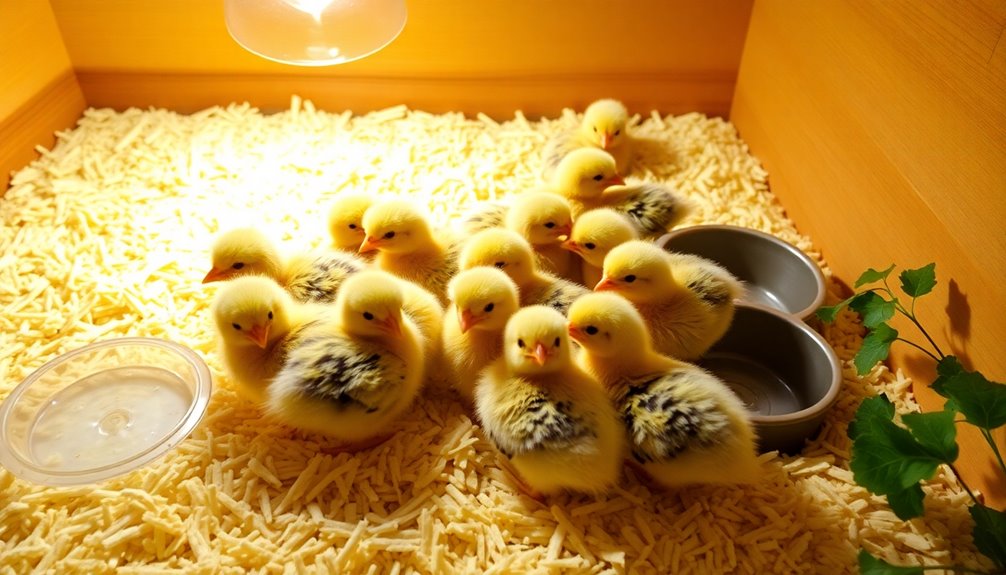
Creating a suitable housing environment for young quail is essential for their development and overall health. Your brooder should provide about 0.5 square feet of space per chick, guaranteeing comfort and minimizing stress. Start with a brooder temperature of 35°C (95°F), reducing by 5°F weekly to prevent overheating. Use solid sides to retain heat, and install a wire mesh top for adequate ventilation and safety from predators.
| Requirement | Description |
|---|---|
| Brooder Temperature | Start at 35°C, decrease weekly |
| Bedding Cleanliness | Change frequently for health |
| Ventilation | Guarantee airflow while blocking the elements |
Maintaining bedding cleanliness and humidity control will create a stable microclimate for your quail.
Nutrition for Growing Quail
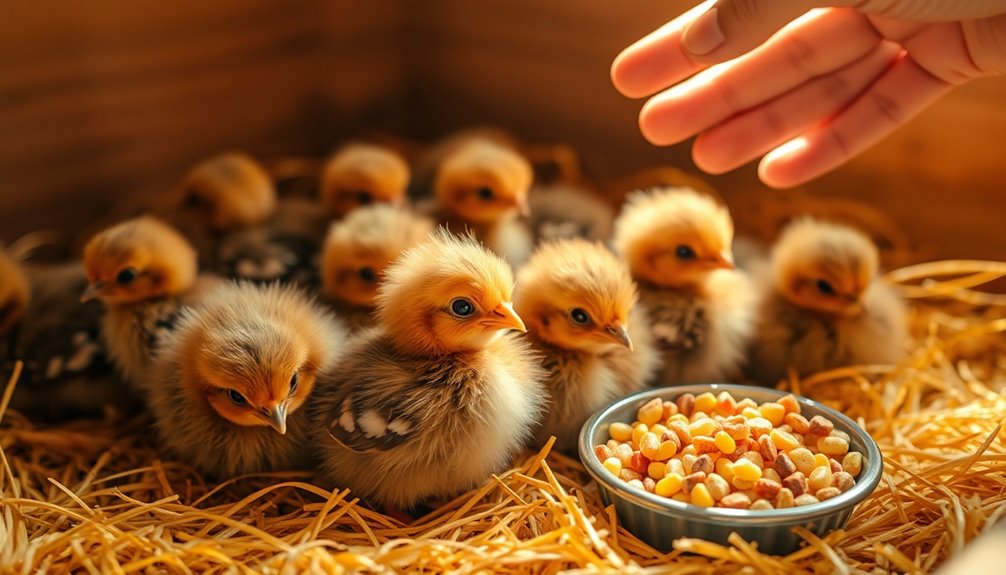
To raise healthy quail, you need to focus on their nutritional requirements, including the right feed and feeding schedule.
Providing fresh water at all times is essential for their hydration and growth.
Essential Nutritional Requirements
When raising healthy quail, you'll find that their nutritional needs are vital for successful growth.
Young quail require a high-protein diet, so opt for crumble feed with 25-30% protein to support their rapid development. Always provide fresh water, as hydration is essential from day one.
While grit isn't necessary for crumble feed, it's important if you offer supplemental treats like mealworms, helping with digestion. A balanced diet can also include hemp seeds and garden scraps to guarantee healthy growth.
Regular feeding schedules are key to maintain consistent nutrient intake, allowing your quail to reach maturity in just 6-12 weeks.
Pay attention to their needs, and you'll raise thriving, happy quail!
Optimal Feeding Schedule
Establishing an ideal feeding schedule is essential for the healthy growth of your quail. Start by feeding your newly hatched quail chicks a high-protein crumble containing 25-30% protein every 2-3 hours for the first few days. This frequent feeding guarantees they get the nourishment they need to thrive.
Always provide fresh water in shallow dishes to prevent drowning, and consider adding "magic water" like garlic, apple cider vinegar, or honey to enhance their immune systems.
As your quail mature, shift to a regular feeding schedule and reduce the protein content to 20-25% after six weeks. Supplement their diet with treats like freeze-dried mealworms or garden scraps, but only offer grit when serving whole grains or treats.
Water Management Tips
Proper water management is essential for the health and growth of your quail. Guarantee clean water is always available to prevent dehydration, as young quail are especially sensitive to water quality.
Use shallow dishes or quail-specific waterers to minimize drowning risks and spills. Incorporate "magic water" solutions like garlic, apple cider vinegar, or honey to boost their immune system and promote overall health.
Regularly clean water sources to prevent harmful bacteria growth; ideally, wash them daily and guarantee they're sanitized. Monitor water consumption closely, as inadequate hydration can lead to poor growth rates and increased vulnerability to diseases.
Brooding Process Overview
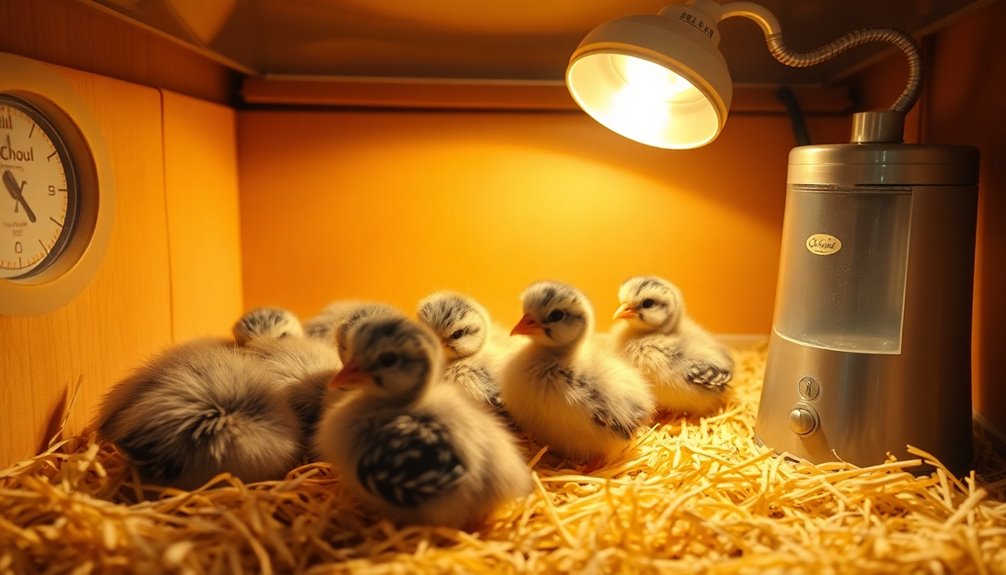
As you prepare for the brooding process, it's essential to set up a comfortable environment for your quail chicks.
You'll need to manage temperature and humidity carefully while monitoring their health closely.
With the right preparation, your chicks will thrive in their new home.
Brooder Preparation Essentials
During the essential brooding period, which lasts from hatching until the chicks are 4-6 weeks old, you'll need to create a warm and safe environment for your quail.
Begin with proper brooder preparation by making sure you have adequate brooder space, allocating about 0.5 square feet per day-old quail chick. A reliable heat source is vital; start with a temperature of around 35°C (95°F), decreasing it by 5°F weekly.
Guarantee ventilation by using a wire mesh top while maintaining solid sides to block drafts. Regularly check your waterers, cleaning them frequently to prevent bacteria growth.
Change bedding every few days and consider a modified deep litter method to keep the environment clean and comfortable for your growing quail.
Temperature and Humidity Control
Achieving the right temperature and humidity levels is essential for your quail's health in the brooding process. Start with a brooder temperature of around 35°C (95°F) and decrease it by 5°F weekly to guarantee proper growth.
Aim to maintain humidity levels between 45-55% to support chicks' health.
Here are some key tips for effective temperature and humidity control:
- Use thermometers in multiple areas to guarantee a stable environment.
- Keep the brooder in a draft-free, climate-controlled area to prevent stress.
- Regularly monitor behavior; huddling indicates cold, while spreading out suggests warmth.
Monitoring Chick Health
Keeping a close eye on your quail chicks is vital during the brooding process. Regularly monitoring chick health is important for their survival and growth.
Start with temperature management; keep it at 35°C (95°F) and decrease it by 5°F weekly. Make certain waterers are washed and bleached frequently to prevent bacteria growth.
Change bedding often to control humidity and waste, which also helps prevent brooding health issues like splay legs and failure to thrive. Pay attention to any unusual behaviors, as these can signal potential health problems.
Finally, limit exposure to other animals and humans until their immune systems develop fully. By taking these steps, you'll guarantee your quail chicks thrive during this critical period.
Monitoring Health and Behavior
Monitoring the health and behavior of your quail is essential for their well-being and productivity. Pay attention to several key factors:
- Maintain the temperature in the brooder at around 95°F, decreasing by 5°F weekly to prevent stress in young quail.
- Confirm you provide adequate space, around 0.5 square feet per chick, to reduce aggressive behavior and promote a calmer environment.
- Keep fresh water available at all times and watch for signs of health issues, like lethargy or poor appetite, which can indicate dietary deficiencies.
Additionally, monitor your male-to-female ratio, ideally 1:4, to minimize conflicts.
Regularly observing these aspects will help you raise healthy, happy quail and address any potential health issues promptly.
Importance of Clean Water
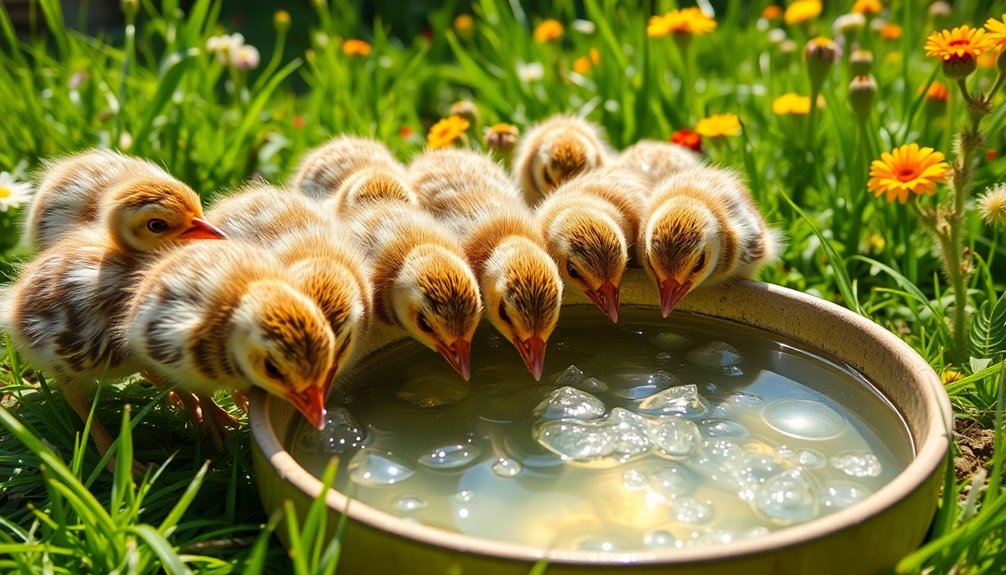
Clean water is crucial for the health and development of young quail. It prevents dehydration and supports quail chicks during their critical early stages. Providing a shallow water dish guarantees safe access to hydration, reducing the risk of drowning. By regularly changing the water and cleaning the dishes, you minimize bacterial growth that can lead to illness.
Consider using "magic water," a mix of garlic, apple cider vinegar, and honey, to boost their immune systems and overall health. Consistent access to clean water is imperative—brief periods without it can cause stress and hinder growth in your quail chicks.
| Water Importance | Effects |
|---|---|
| Clean Water | Prevents dehydration |
| Shallow Dishes | Guarantees safety |
| Regular Changes | Reduces bacterial growth |
| Magic Water | Boosts immune systems |
Common Challenges in Brooding
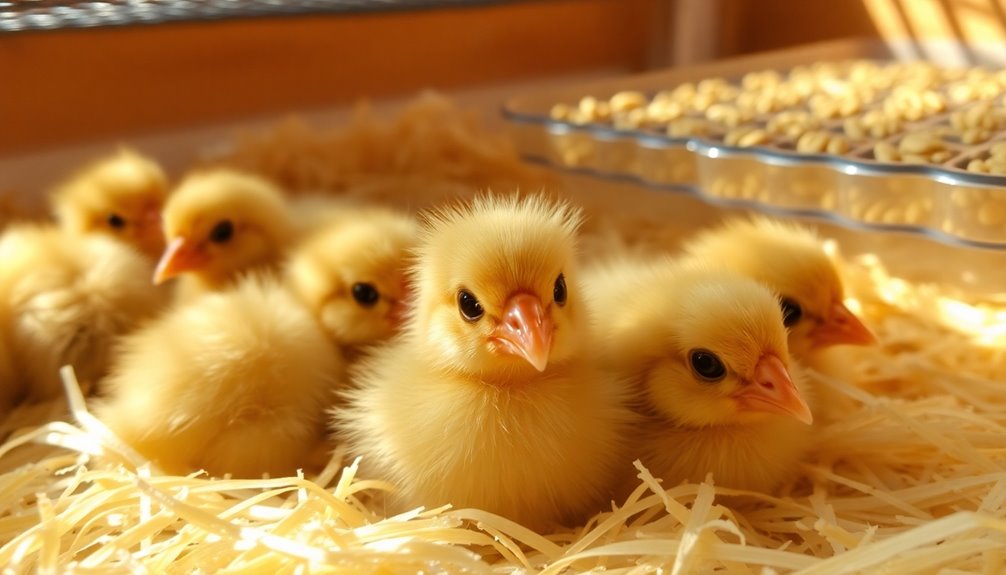
Providing your quail with a safe and healthy environment during the brooding phase can be challenging. You need to maintain the correct temperature, humidity control, and ventilation to guarantee their well-being.
Here are some common challenges to watch for:
- Temperature: Start at 35°C (95°F) and reduce by 5°F weekly to prevent stress.
- Health Issues: Regularly check for dehydration and conditions like splay legs that could hinder growth.
- Clean Water & Fresh Bedding: Ascertain fresh bedding is changed frequently to manage waste and moisture, and always provide clean water to avoid dehydration.
Additionally, ensuring proper ventilation is crucial to prevent respiratory issues among your quail.
Enrichment and Interaction Ideas
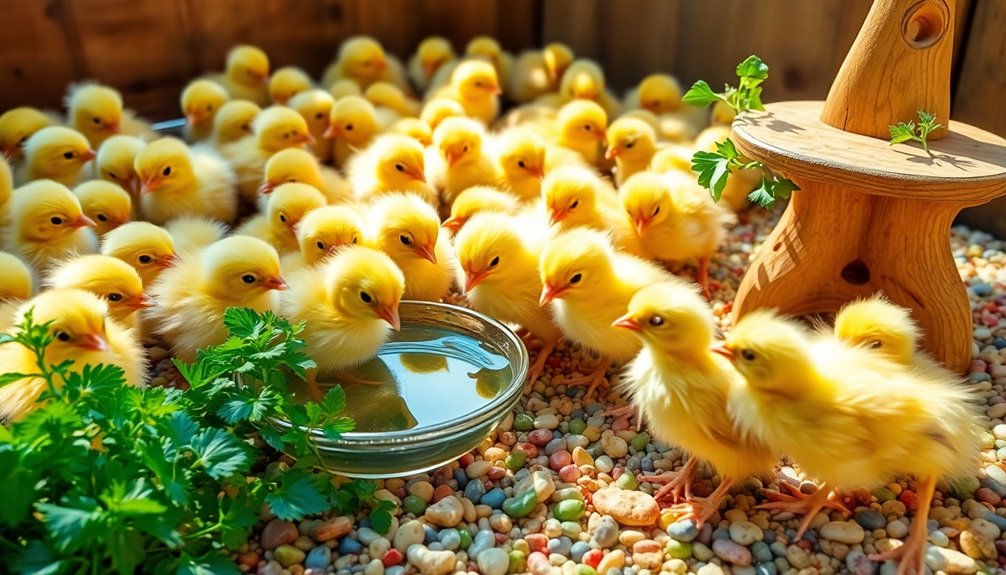
To foster a thriving environment for your young quail, incorporating enrichment activities and interaction is essential. Offering freeze-dried mealworms or garden scraps encourages their natural foraging behaviors, enhancing overall well-being.
Create a dedicated dust bath area to promote grooming behaviors, which keep their feathers and skin healthy. Regular interaction, like gentle handling and naming your quail, helps them become comfortable around humans and reduces stress.
Introduce varied perches and hiding spots in their enclosure to encourage exploration and provide personal space. Additionally, safe toys like small mirrors or hanging greens offer mental stimulation, preventing boredom among your young quail.
These activities not only enrich their lives but also contribute to their happiness and health.
Transitioning to Adult Quail
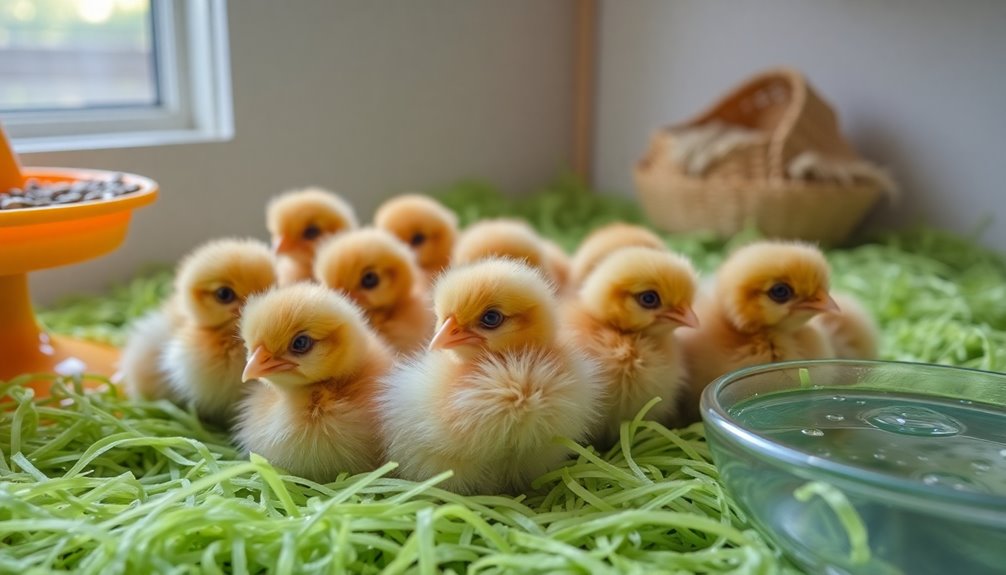
As your young quail reach the age of 4 to 6 weeks, it's time to change them into adult housing. Make sure each quail has at least 1 square foot of space to promote comfort and reduce aggression.
Here are some key aspects to take into account during this conversion phase:
- Maintain a male-to-female ratio of 1 male to 4 females to prevent overbreeding.
- Provide a protein diet with 20-25% protein by switching to game bird breeder feed.
- Monitor environmental conditions, guaranteeing good ventilation and a safe, draft-free area.
Regularly check for health issues like feather pecking or lethargy.
Incorporate enrichment activities, such as dust baths, to promote well-being in your adult quail.
Resources for Successful Raising
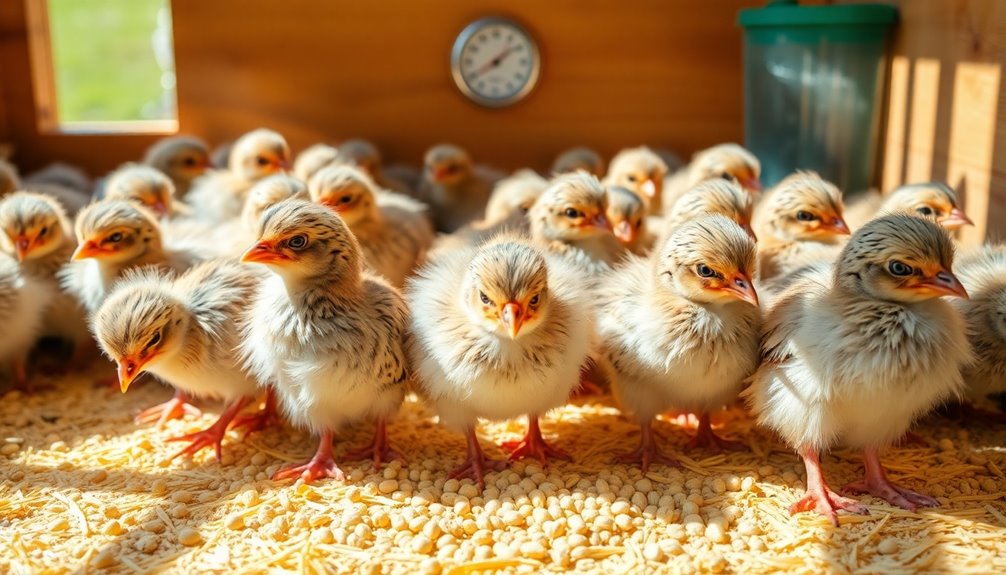
When raising quail, having the right resources at your fingertips can make a significant difference in their health and productivity.
Start with a high-quality Game Bird Starter feed, containing 25-30% protein, to support ideal growth for the first ten weeks.
Maintain hygiene by implementing a modified deep litter method with fresh bedding daily and cleaning the brooder every 2-4 days.
Monitor brooder temperatures closely, beginning at 35°C (95°F) and reducing by 5°F weekly for a comfortable environment.
Always provide access to fresh water in shallow dishes to prevent drowning, and consider enhancing hydration with "magic water."
Stay vigilant for health issues like splay legs and failure to thrive, and be ready to intervene as necessary.
Frequently Asked Questions
What Do 1 Day Old Quail Eat?
When you have one-day-old quail, they need a high-protein starter feed that offers 25-30% protein to support their growth.
Game Bird Starter crumbles are perfect since they're formulated for young quail.
Make certain you provide fresh, clean water in shallow dishes to keep them safe and hydrated.
If you introduce treats like mealworms, remember to offer grit, but it's unnecessary if they're only eating crumble feed.
Keeping their environment clean is essential for their health.
How Do You Make a Quail Happy?
To make your quail happy, create a cozy and secure environment for them.
Provide a well-ventilated hutch that protects against predators.
Keep their diet balanced with high-protein feed and occasional treats to keep them engaged.
Offer enrichment activities like dust baths and garden treats to stimulate their natural behaviors.
Regularly interact with them, observe their personalities, and name them to foster a sense of comfort and reduce stress.
Happy quail thrive!
How Long Do Baby Quail Need a Heat Lamp?
You'd think baby quail could handle the cold like little feathered warriors, but they actually need that heat lamp for the first week, maintaining a cozy 95°F (35°C).
As they grow, you'll gradually lower the temperature by 5°F (2.5°C) each week until they're basking in a comfy 70°F (21°C) by 5-6 weeks.
Keep an eye on their behavior; they'll tell you if they're too hot or too cold!
At What Age Can a Baby Quail Go Outside?
You can introduce baby quail to the outdoors around four weeks of age, once they're fully feathered and can regulate their body temperature.
Before making the switch, confirm the outdoor area is secure from predators and offers shelter.
Start with short, supervised visits to help them acclimate.
Keep an eye on their behavior and health, and always provide fresh water and appropriate feed to meet their hydration and nutritional needs.
Conclusion
In raising young quail, you're not just providing shelter and food; you're creating a thriving environment where each little chirp echoes the joy of growth. Just like the sun rises each morning, illuminating their journey from fluffy chicks to vibrant adults, your care sparks their transformation. By staying attentive and adapting to their needs, you'll witness the delightful coincidence of health and happiness flourishing, leading to a flock that brings endless charm to your life.

